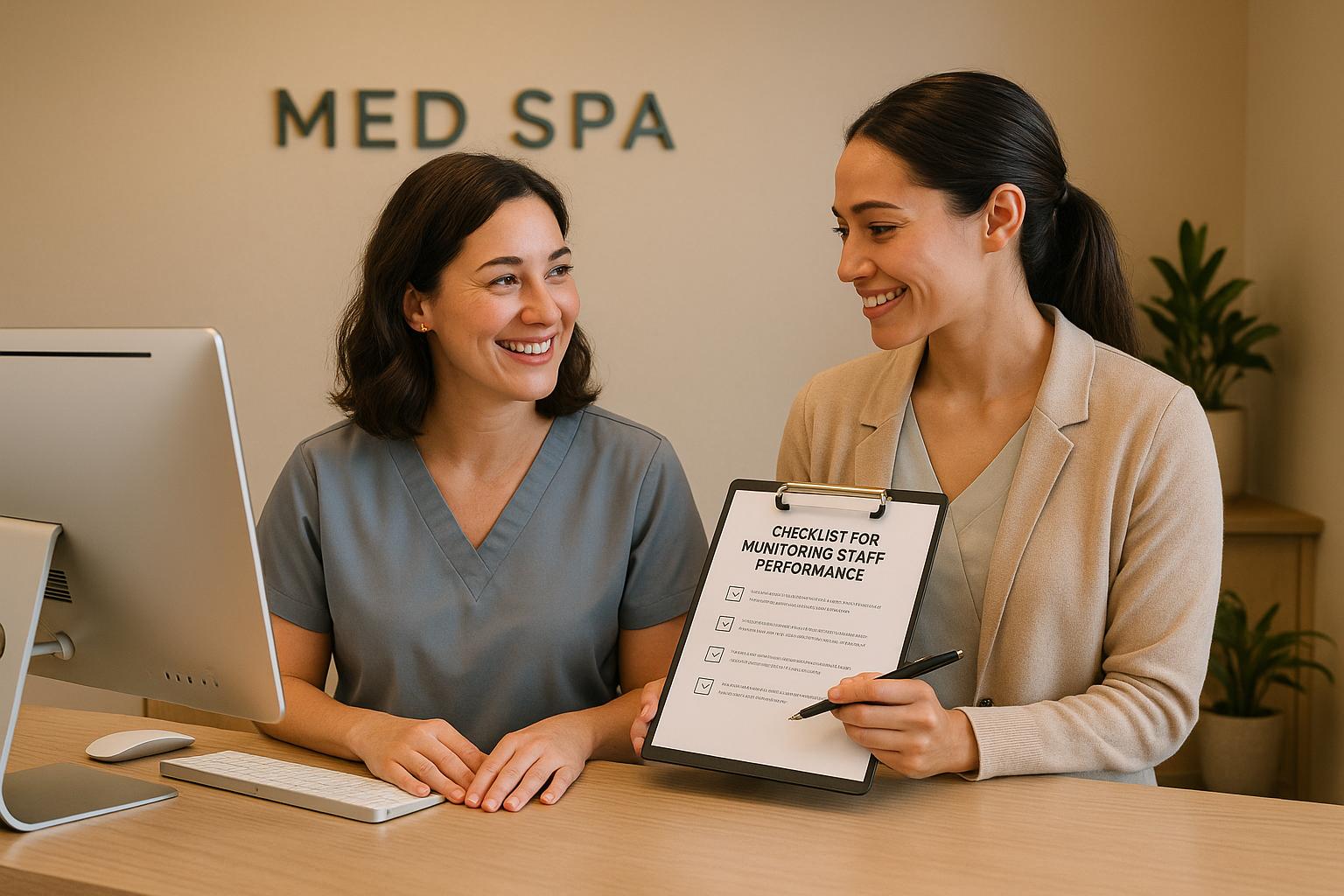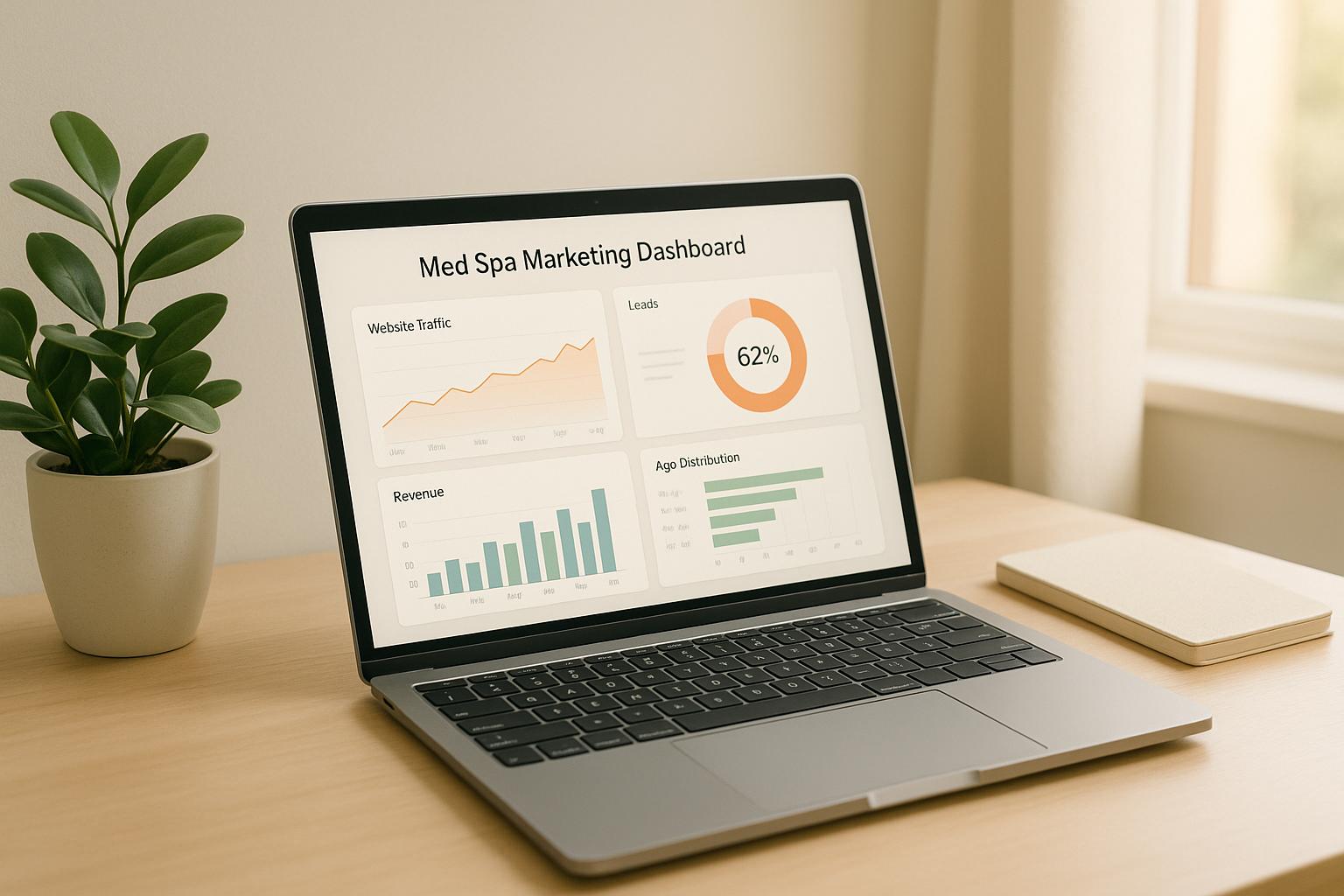Monitoring staff performance in med spas is essential for improving client retention, increasing revenue, and identifying areas for staff development. Instead of relying on guesswork or basic revenue numbers, tracking specific metrics provides actionable insights into staff contributions and operational efficiencies. Here’s what you should focus on:
- Pre-Book Percentage: Measures how many clients book follow-up appointments before leaving. Low rates may signal the need for better communication training.
- Service and Retail Sales: Tracks revenue generated from treatments and product sales, highlighting staff strengths and areas for improvement.
- Client Retention and Rebooking Rates: Indicates how well staff build client loyalty and encourage repeat visits.
- Revenue and Efficiency Metrics: Includes revenue per hour worked, capacity utilization, and average treatment time to assess productivity.
- No-Show and Cancellation Rates: Identifies scheduling or communication issues impacting staff performance.
Using modern practice management platforms like Prospyr simplifies data collection and analysis, providing real-time insights and AI-powered analytics. These tools help you set clear benchmarks, centralize data, and adjust strategies based on performance trends. Regular reviews, clear communication, and tailored coaching ensure continuous improvement and a stronger med spa business.
Key Staff Performance Metrics to Track
Measuring staff performance means keeping an eye on metrics that directly reflect each team member's contribution to your med spa's success.
Pre-Book Percentage
Pre-booking is a strong indicator of client trust and satisfaction. When clients schedule their next appointment before leaving, it shows confidence in both your staff and the treatments they provide.
Keep track of the percentage of clients each staff member successfully pre-books for future visits. If pre-booking rates are consistently low, it might signal a need for better training in communication or treatment planning. It could also point to challenges in explaining the value of follow-up treatments or building lasting client relationships.
Dig deeper by monitoring pre-booking rates by treatment type. Some services naturally encourage regular bookings, while others may require a more tailored approach to secure reappointments. Understanding these trends can help you set realistic goals and provide focused coaching where it’s needed.
Next, take a closer look at revenue generation through service and retail sales.
Service and Retail Sales
Beyond pre-booking, evaluating staff performance through service and retail sales offers a fuller picture. Revenue generation isn’t just about delivering treatments; it also involves upselling products and creating value for clients.
Track service revenue to see how well team members convert consultations into treatments and whether they’re effectively promoting comprehensive service packages. Metrics like average ticket size and conversion rates can provide actionable insights.
Retail sales, whether measured in dollars or as a percentage of service revenue, reveal how well staff educate clients on products and encourage purchases. Some team members may excel at retail sales, while others might need additional support. Tailoring coaching to these strengths and weaknesses helps set realistic and motivating performance goals.
Client Retention and Rebooking Rates
Client retention is another critical measure of staff performance. Building long-term relationships with clients is essential for sustainable growth. Monitor how many clients return to specific practitioners over time to gauge satisfaction and loyalty.
Retention rates can be calculated by comparing the number of returning clients to the total number of new clients seen within a given period. Strong retention rates are a hallmark of successful practices.
Rebooking rates offer another layer of insight. These rates measure how often clients schedule additional appointments, even if they fall outside the typical retention window. For example, some clients may return seasonally or for specific follow-up treatments. Tracking these patterns by treatment type and practitioner specialty can uncover best practices that can be shared across your team.
Revenue and Efficiency Metrics
Operational efficiency plays a big role in profitability. Key metrics to track include revenue per hour worked, capacity utilization, and average treatment time.
- Revenue per hour worked: This metric shows how effectively staff members turn their time into income. It’s calculated by dividing total revenue by the hours worked, covering both treatments and consultations. Variations in this metric can reveal differences in roles, treatment types, or local market conditions.
- Capacity utilization: This measures how much of the available appointment time is filled with paying clients. Aim for high utilization rates while leaving enough room for consultations and administrative tasks.
- Average treatment time: This helps identify efficiency trends. Practitioners who routinely exceed scheduled times may need additional training or schedule adjustments. On the flip side, those who finish appointments unusually quickly might be accommodating more clients - or potentially rushing through treatments.
These metrics provide a solid foundation for evaluating appointment reliability, particularly through no-show and cancellation tracking.
No-Show and Cancellation Rates
Missed appointments can disrupt operations and hurt revenue. Tracking no-show and cancellation rates for each staff member can help identify patterns that need attention.
- No-show rates: Calculate these by comparing the number of missed appointments to the total scheduled. High rates might indicate issues with appointment confirmations or client communication.
- Cancellation rates: Frequent cancellations could point to challenges like pricing concerns, overly advanced scheduling, or unclear pre-appointment instructions. Breaking these metrics down by appointment type or time of day (e.g., morning vs. evening slots) can provide deeper insights into scheduling trends and highlight areas for improvement.
Performance Monitoring Implementation Checklist
Use this checklist to turn performance metrics into actionable strategies, driving your med spa's growth and success.
Set Clear Performance Benchmarks
Start by defining specific targets for each metric you track. Use your practice's historical data, industry standards, and your unique goals to set these benchmarks. For example, pre-booking rates for treatments like injectables or maintenance procedures often show higher consistency compared to one-time consultations. Clearly document each target, how it’s calculated, and how often it will be reviewed. Share this information with your team so everyone knows what’s expected.
For revenue, calculate a baseline revenue per hour by analyzing recent data, and set realistic improvement goals based on market trends and your med spa's capacity. Similarly, establish client retention goals that align with the services you offer - some treatments naturally encourage more frequent visits than others.
Keep all benchmarks organized in a reference document to avoid confusion and ensure consistency when reviewing performance over time. Once benchmarks are set, focus on centralizing your data for accurate tracking.
Centralize Data Collection
Manually tracking performance data can lead to errors and missed opportunities. Instead, use a practice management platform like Prospyr to streamline data collection and reduce administrative work. Prospyr's built-in analytics automatically track key metrics across appointments, treatments, and retail sales, giving you a complete view of staff performance without manual input.
Automate data collection for appointment outcomes, payments, and client communications to ensure every interaction is recorded. This should include tracking successful appointments, cancellations, and the reasons behind any changes.
Take advantage of Prospyr's HIPAA-compliant, role-based access controls to ensure secure data sharing. With these controls, team members can only view performance data relevant to their responsibilities.
Sync your data in real time to identify trends quickly and make informed operational decisions, such as adjusting staff schedules or reallocating resources. Once your data is centralized, regular analysis will help you turn metrics into actionable strategies.
Analyze and Act on Insights
Gathering data is just the beginning - regular analysis is where the real value lies. Set a routine review schedule, such as monthly, to identify trends, spot outliers, and address performance gaps.
Hold data-driven performance reviews with each team member to celebrate successes and tackle areas needing improvement. If you notice a decline in a key metric, dig deeper to uncover and address possible causes, such as changes in protocols or scheduling practices.
Compare performance across similar roles to uncover best practices. For example, if one team member consistently exceeds targets, document their methods and use them as a training model for others. Create action plans with clear, measurable goals and deadlines, rather than vague improvement suggestions.
Monitor the impact of any changes by reviewing performance data before and after implementing new strategies. Use your practice management platform’s reporting tools to quickly spot trends and ensure your med spa stays on track toward its objectives.
Using Practice Management Tools for Metrics Tracking
Modern practice management platforms are reshaping how med spas monitor and evaluate staff performance. Gone are the days of juggling spreadsheets - these tools provide real-time insights that empower you to make smarter decisions about your team and operations.
Automated Reporting and Dashboards
Real-time dashboards take the guesswork out of performance tracking. With Prospyr's analytics, data from client interactions, appointments, and transactions is automatically compiled into clear, visual reports. This means you can quickly access individual staff metrics, compare team performance, and identify practice-wide trends without spending hours crunching numbers.
Customizable reports let you zero in on the metrics that matter most to your med spa. Whether it’s weekly pre-booking summaries, monthly revenue by staff member, or quarterly client retention rates, automated reporting ensures you always have up-to-date data. This makes it easier to spot performance shifts as they happen.
Dashboards can also be tailored to suit different roles within your team. For example, front desk staff might focus on scheduling efficiency and no-show rates, while treatment providers can track service sales and client satisfaction scores. This role-specific approach helps everyone stay focused on their individual goals.
On top of these robust dashboards, AI tools enhance the depth of insights, making decision-making even smarter.
AI-Powered Insights for Decision Making
Artificial intelligence takes performance tracking to the next level by uncovering patterns and trends that might otherwise go unnoticed. Prospyr's AI tools analyze past data to predict future trends, helping you prepare for staffing needs and address potential challenges before they arise.
AI also tracks client interactions and preferences, offering insights into team performance. For instance, it can reveal which staff members excel at converting consultations into treatments or consistently receive positive client feedback. These insights allow you to identify top performers and understand what drives their success.
Beyond highlighting strengths, AI-powered analytics pinpoint areas for improvement. The system might identify higher cancellation rates for certain staff during specific times or show how particular service combinations improve client retention. Paired with automated reporting, these insights create a well-rounded strategy to boost staff performance and streamline operations.
Data Security and HIPAA Compliance
While advanced analytics improve efficiency, safeguarding data is critical. In the medical aesthetics field, performance tracking must comply with strict privacy regulations. Prospyr’s HIPAA-compliant infrastructure ensures that both staff performance data and client information are securely managed.
The platform uses secure storage and transmission protocols to protect sensitive data from breaches. Regular updates and monitoring ensure compliance with HIPAA standards without requiring extra IT resources.
Additionally, automated data backup and recovery features safeguard your performance tracking history. This means you’ll never lose valuable insights into staff development or business growth, giving you the confidence to make long-term decisions based on reliable data.
sbb-itb-02f5876
Best Practices for Ongoing Performance Monitoring
Tracking and analyzing key metrics is just the first step. To truly see results, you need to keep the momentum going with consistent performance practices. Regular performance meetings and transparent communication are essential for keeping your team engaged and your med spa on a growth trajectory. Here are some strategies to maintain a sustainable approach that benefits both your business and your staff.
Regular Team Meetings and Feedback
Make it a habit to hold individual sessions to review specific metrics and set measurable goals. Pair these with weekly team huddles to celebrate wins and tackle challenges. The focus should always be on clear, actionable data points rather than vague observations.
Create an open feedback loop where staff can voice challenges tied to specific metrics. For example, a front desk employee might point out that inconsistent client reminders are impacting appointment attendance. Similarly, treatment providers might highlight the need for additional training to improve retail sales. Document these discussions and follow up on action items to show that feedback leads to action.
Building Accountability and Motivation
Accountability among peers can drive better results. Pair high-performing team members with those looking to improve in specific areas. This kind of mentorship helps share effective techniques and boosts overall team performance.
Recognize achievements based on concrete metrics like client retention or retail sales growth. Move beyond generic awards like "Employee of the Month" and instead celebrate specific accomplishments. For example, reward improvements in reducing no-shows or increasing retail sales. Incentives such as flexible scheduling or opportunities for continuing education can further motivate your team.
Clearly communicate team-wide goals and explain how each metric contributes to overall success. Setting small, achievable improvement targets can build both confidence and momentum. If performance concerns arise, address them promptly with a supportive conversation rather than waiting for the next formal review.
These motivational tactics naturally lead to regular benchmark reviews and adjustments to performance targets.
Adjusting Benchmarks and Strategies
Over time, benchmarks and client expectations will evolve, so it’s important to periodically revisit and refine your performance standards. Seasonal shifts can influence booking patterns and service preferences, which means benchmarks may need to adapt throughout the year. As your team expands and roles become more specialized, you might also need to tailor benchmarks to reflect varying levels of experience and responsibility.
Review targets whenever new technology or service changes impact performance. For instance, if a new booking system improves attendance rates, your benchmarks should reflect this. Likewise, changes in local market conditions may influence what’s achievable. Regularly reassess expectations and strategies with input from your team to ensure they remain relevant and continue to drive progress. This collaborative approach keeps your med spa on a path of steady improvement.
Conclusion: Building a Data-Driven Med Spa
Tracking staff performance metrics takes your med spa from relying on assumptions to making well-informed, data-backed decisions. By regularly monitoring key indicators - like pre-book percentages, retail sales figures, and client retention rates - you can clearly identify what’s working and where there’s room for growth.
For instance, studies reveal that 51% of organizations without automated performance measurement systems face challenges with data accuracy and effective decision-making. Acting on these insights can lead to more productive staff, happier clients, and a noticeable boost in revenue.
Tools such as Prospyr make this process easier by automating data collection and simplifying performance tracking. The results speak for themselves: a 69% lead-to-appointment rate, 34% fewer no-shows, and a 14% increase in revenue. These outcomes stem from minimizing manual errors and delivering actionable insights that might otherwise go unnoticed.
Consistency and follow-through are key to sustaining these improvements. Regularly reviewing performance and adjusting benchmarks ensures continuous progress. When team members see how their efforts directly contribute to the med spa’s success, engagement improves, creating a ripple effect of better client experiences, stronger retention, and higher earnings.
FAQs
What is the best way for med spa managers to use pre-book percentage metrics to boost staff performance?
Pre-book percentage metrics serve as an invaluable way for med spa managers to gauge how well their team is persuading clients to schedule their next appointments before they walk out the door. High pre-booking rates typically reflect strong client relationships and a high level of trust.
By analyzing these numbers, managers can pinpoint standout staff members, provide focused coaching for those who may need a little extra guidance, and even introduce incentives to boost performance. This approach doesn’t just enhance team productivity - it also improves client retention, keeps scheduling more predictable, and contributes to the clinic’s overall growth.
How can med spas effectively use AI to monitor staff performance?
To make the most of AI for monitoring staff performance in med spas, start by using AI-driven tools such as automated scheduling systems, task management platforms, and performance analytics software. These tools not only simplify daily operations but also deliver real-time insights into productivity and staff efficiency.
Equipping your team with proper training on these technologies is key to ensuring a smooth transition and getting the most out of these systems. Tools like AI-powered virtual assistants or chatbots can also monitor staff-patient interactions, providing valuable feedback to refine employee performance and enhance patient satisfaction.
When implemented thoughtfully, AI can help med spas improve operational efficiency while delivering a more reliable and top-notch experience for clients.
How can using a platform like Prospyr improve staff performance tracking in a med spa?
Using a platform like Prospyr makes tracking staff performance much easier by pulling all the necessary data into one place. This not only cuts down on errors but also saves time and provides clearer insights into important performance metrics.
With tools like real-time analytics and automation, you can keep an eye on staff productivity, client interactions, and overall performance without the hassle. This efficient system allows med spa owners to make smarter decisions based on data, improving both team efficiency and client satisfaction.



